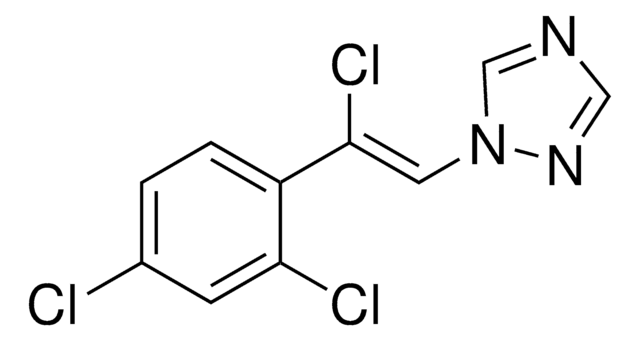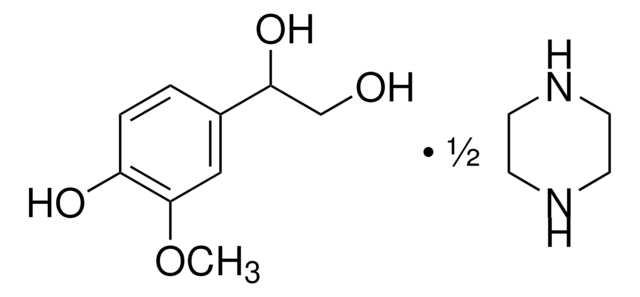所有图片(1)
别名:
(5Z,8Z,11Z,14Z,17Z)-N-(2-Hydroxyethyl)-5,8,11,14,17-eicosapentaenamide, EPEA
经验公式(希尔记法):
C22H35NO2
推荐产品
质量水平
检测方案
≥98% (HPLC)
形式
solution
药品控制
regulated under CDSA - not available from Sigma-Aldrich Canada
储存条件
protect from light
under inert gas
浓度
5 mg/mL in absolute ethanol
颜色
light yellow
储存温度
−20°C
SMILES字符串
CC\C=C/C\C=C/C\C=C/C\C=C/C\C=C/CCCC(=O)NCCO
InChI
1S/C22H35NO2/c1-2-3-4-5-6-7-8-9-10-11-12-13-14-15-16-17-18-19-22(25)23-20-21-24/h3-4,6-7,9-10,12-13,15-16,24H,2,5,8,11,14,17-21H2,1H3,(H,23,25)/b4-3-,7-6-,10-9-,13-12-,16-15-
InChI key
OVKKNJPJQKTXIT-JLNKQSITSA-N
生化/生理作用
Eicosapentaenoyl ethanolamide (EPEA) is a lipid mediator that has been found to suppress lifespan extension resulting from dietary restriction in C. elegans and also to have antiproliferative and anti-inflammatory actions. In C. elegans, it is believed to act as a metabolic signal that couples nutrient availability with growth and lifespan. EPEA is a member of the N-acylethanolamines (NAEs), lipid-derived signaling molecules that include the mammalian endocannabinoid arachidonoyl ethanolamide (AEA). In mammals, NAEs are believed to act primarily through cannabinoid receptors, although they can also interact with a variety of other targets, and EPEA has been shown to act as a CB1 and CB2 receptor agonist. However, C. elegans does not possess clear orthologues of the mammalian cannabinoid receptors which suggests that there are unidentified NAE receptors in nematodes that are possibly conserved mediators of NAE signaling.
其他说明
Light and air sensitive; store in a freezer.
WGK
WGK 3
闪点(°F)
Not applicable
闪点(°C)
Not applicable
Mark Lucanic et al.
Nature, 473(7346), 226-229 (2011-05-13)
Dietary restriction is a robust means of extending adult lifespan and postponing age-related disease in many species, including yeast, nematode worms, flies and rodents. Studies of the genetic requirements for lifespan extension by dietary restriction in the nematode Caenorhabditis elegans
Strahil Iv Pastuhov et al.
Nature communications, 3, 1136-1136 (2012-10-18)
The ability of neurons to regenerate their axons after injury is determined by a balance between cellular pathways that promote and those that inhibit regeneration. In Caenorhabditis elegans, axon regeneration is positively regulated by the c-Jun N-terminal kinase mitogen activated
Celina Galles et al.
Scientific reports, 8(1), 6398-6398 (2018-04-25)
Proper cholesterol transport is crucial for the functionality of cells. In C. elegans, certain cholesterol derivatives called dafachronic acids (DAs) govern the entry into diapause. In their absence, worms form a developmentally arrested dauer larva. Thus, cholesterol transport to appropriate
Michiel G J Balvers et al.
Metabolomics : Official journal of the Metabolomic Society, 8(6), 1130-1147 (2012-11-09)
It is well established that dietary intake of n-3 fatty acids is associated with anti-inflammatory effects, and this has been linked to modulation of the oxylipin and endocannabinoid metabolomes. However, the amount of data on specific tissue effects is limited
Sylvie Callegari et al.
Journal of molecular biology, 431(15), 2835-2851 (2019-05-20)
Mitochondrial membrane proteins with internal targeting signals are inserted into the inner membrane by the carrier translocase (TIM22 complex). For this, precursors have to be initially directed from the TOM complex in the outer mitochondrial membrane across the intermembrane space
我们的科学家团队拥有各种研究领域经验,包括生命科学、材料科学、化学合成、色谱、分析及许多其他领域.
联系技术服务部门






